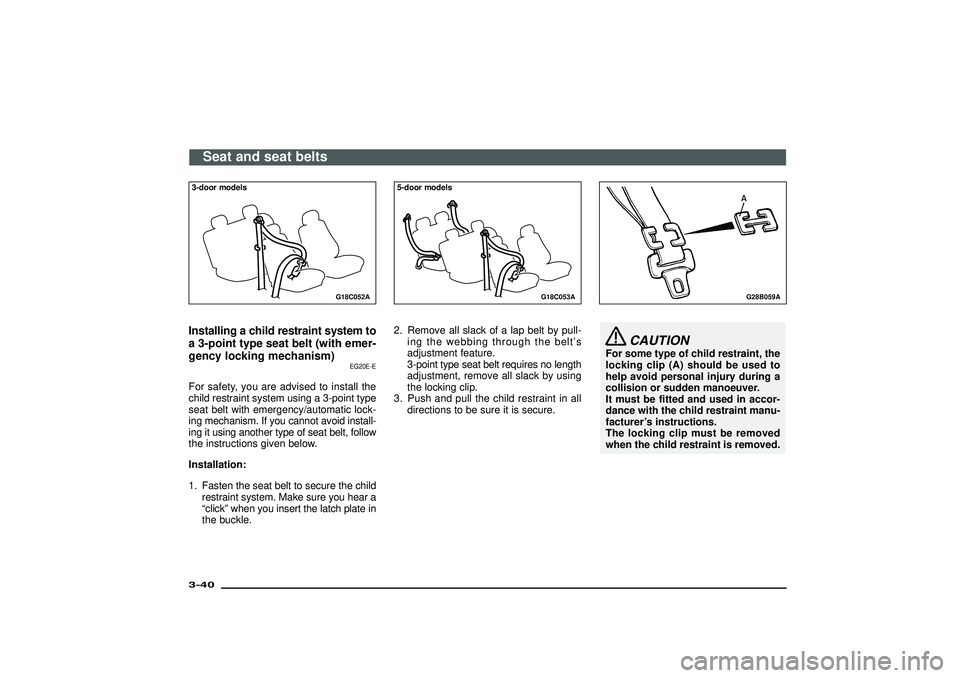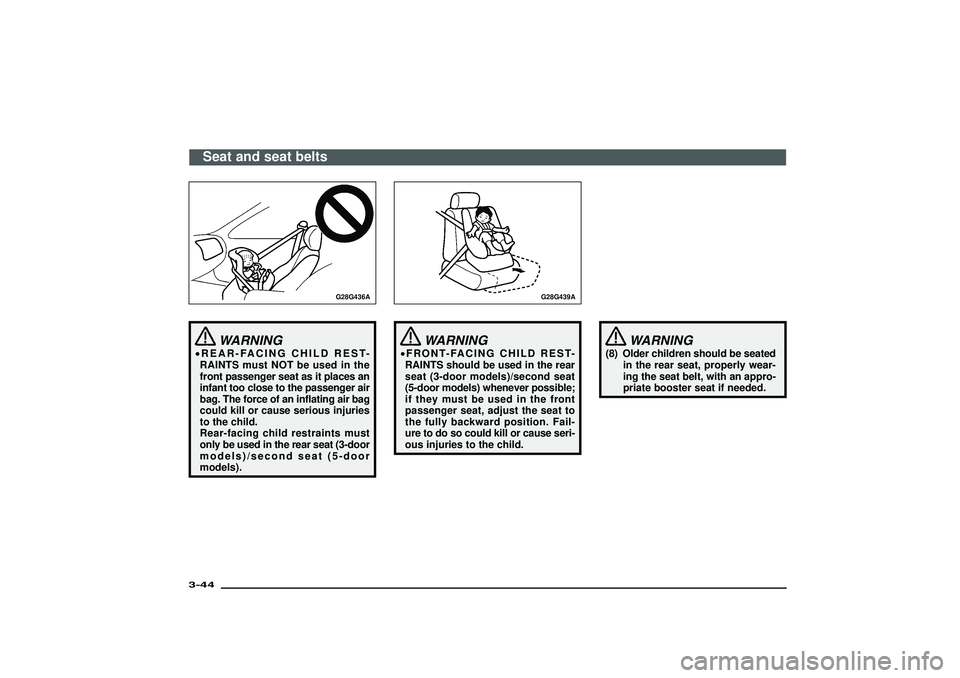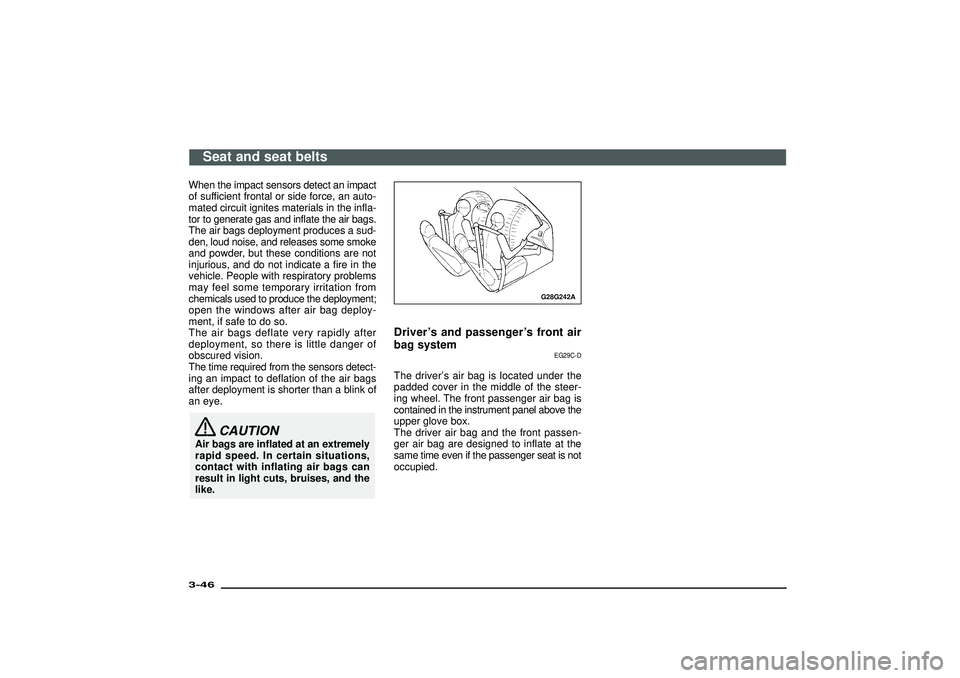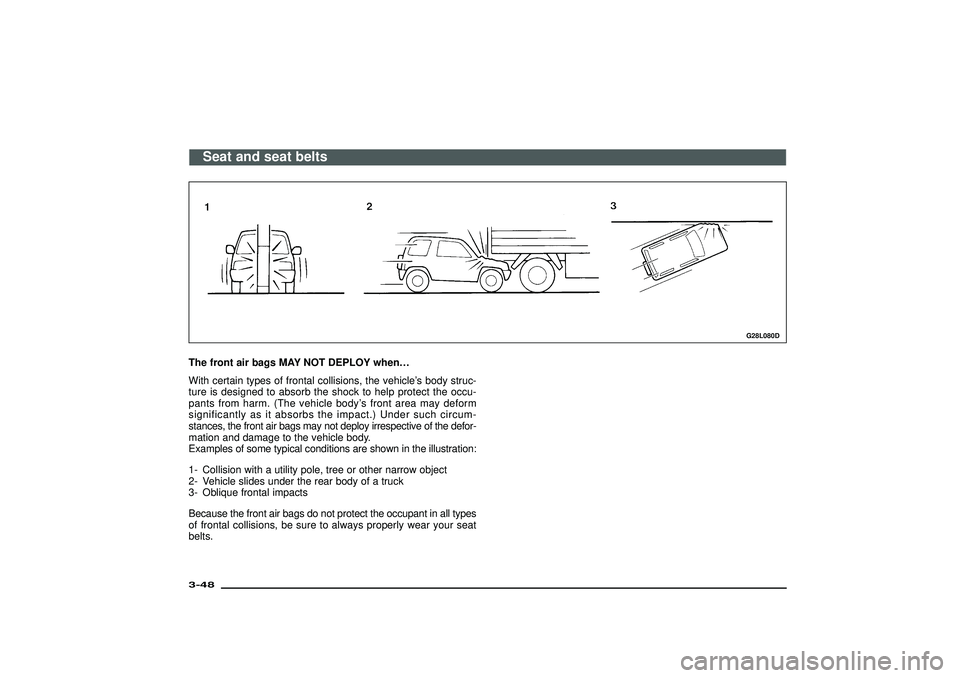MITSUBISHI SHOGUN 2003 (in English) Manual PDF
Manufacturer: MITSUBISHI, Model Year: 2003, Model line: SHOGUN, Model: MITSUBISHI SHOGUN 2003Pages: 392, PDF Size: 14.34 MB
Page 71 of 392

G18C055A
3. To activate the ALR mode, slowly pullthe shoulder part of the belt all the way
out until it stops, then let the belt feed
back into the retractor.
4. After the belt has retracted, tug on it. If the belt is locked, you will not be able to
pull it out. If you can pull the belt out, it
is not locked and you will need to repeat
these steps.
G18C056A
5. After confirming that the belt is locked,grab the shoulder part of the belt near
the buckle and pull up to remove any
slack from the lap part of the belt.
Remember, if the lap part of the belt is
not tight, the child restraint will not be
secure. It may help to put weight on the
child restraint, or push on the seat-
back while pulling up on the belt.
6. Before putting the child in the restraint, push and pull the restraint in all direc-
tions to be sure it is secure. Do this
before each use.
7. To deactivate the ALR mode in order to remove a child restraint etc., after
removing the child from the restraint,
unlatch the buckle, unroute the seat belt,
let the belt fully retract, and rewind the
belt. NOTE
I
f th e sea tbel tdoe sno tlock ,rewin dit full y,
then perform step 2 to 7 again.
WARNING
(1) Before putting the child in the restraint, be absolutely sure to
make the conversion of the
retractor from the ELR mode to
the ALR mode. By doing so, the
child restraint system is always
tightly secured to the seat by the
automatic lock. If the conver-
sion to ALR is not made, the
child restraint system could
move forward in the event of
sudden braking or an accident,
seriously injuring the child or
other occupants.
(2) If a person wearing the seat belt moves one ’s upper body signifi-
cantly such that the belt com-
pletely unwinds, the retractor
may switch to its ALR mode and
lock, thus preventing further
movement. If this happens, the
person should switch the retrac-
tor back to its ELR mode by tak-
ing off the seat belt and fully
rewinding it. The person should
then wear the seat belt again.
Seat and seat belts
3-39
Div:
Out put date:
Page 72 of 392

G18C052A
3-door modelsInstalling a child restraint system to
a 3-point type seat belt (with emer-
gency locking mechanism)
EG20E-E
For safety, you are advised to install the
child restraint system using a 3-point type
seat belt with emergency/automatic lock-
ing mechanism. If you cannot avoid install-
ing it using another type of seat belt, follow
the instructions given below.
Installation:
1. Fasten the seat belt to secure the child
restraint system. Make sure you hear a
“click”when you insert the latch plate in
the buckle.
G18C053A
5-door models2. Remove all slack of a lap belt by pull-
ing the webbing through the belt’s
adjustment feature.
3-point type seat belt requires no length
adjustment, remove all slack by using
the locking clip.
3. Push and pull the child restraint in all
directions to be sure it is secure.
G28B059A
CAUTION
For some type of child restraint, the
locking clip (A) should be used to
help avoid personal injury during a
collision or sudden manoeuver.
It must be fitted and used in accor-
dance with the child restraint manu-
facturer’s instructions.
The locking clip must be removed
when the child restraint is removed.
Seat and seat belts
3-40Div:
Out put date:
Page 73 of 392

Older children
EG20F-Aa
Children who have outgrown child restraint
system should be seated in the rear seat
and wear combination lap shoulder belt.
The lap belt should be snug and posi-
tioned low on the abdomen so that it is
below the top of the hip-bone. Otherwise,
the belt could intrude into the child’s abdo-
men during an accident and cause injury.
CAUTION
(1) Children who are not buckled up
can be thrown out of the vehicle
in an accident.
(2) Children who are not buckled up
can strike other people.
(3) A child should never be left unat-
tended in your vehicle. When
you leave the vehicle, take the
child with you.
Pregnant women restraint
EG28C-Ad
WARNING
Seat belts work for everyone, includ-
ing pregnant women. Pregnant
women should use the available seat
belts. This will reduce the likeli-
hood of injury to both the woman and
the unborn child. The lap belt should
be worn across the thighs and as
snug against the hips as possible,
but not across the waist. The wom-
an’s doctor should be consulted if
there are any questions.Seat belt inspection
EG28D-Da
(1) Check the belts for cuts, worn or frayed
webbing and for cracked or deformed
metallic parts. Replace the belt assem-
bly if defective.
(2) A dirty belt should be cleaned with neu-
tral detergent in warm water. After rins-
ing in water, let it dry in the shade. Do
not attempt to bleach or re-dye the
belts because this affects their char-
acteristics.
WARNING
(1) All seat belt assemblies includ-
ing retractors and attaching
hardware should be inspected
by an authorized MITSUBISHI
dealer after any collision. We
recommend that seat belt
assemblies in use during a col-
lision be replaced unless the col-
lision was minor and the belts
show no damage and continue
to operate properly.
(2) Do not attempt to repair or
replace any part of the seat belt
assemblies; this work should be
done by an authorized MITSUB-
ISHI dealer. Failure to have an
authorized MITSUBISHI dealer
perform the work could reduce
the effectiveness of the belts and
could result in serious injury in
the event of a collision.
(3) Once the pre-tensioner has been
activated, it cannot be re-used. It
must be replaced together with
the retractor.
(4) The entire pre-tensioner seat belt
system must be inspected by an
authorized MITSUBISHI dealer.
Seat and seat belts
3-41
Div:
Out put date:
Page 74 of 392

Supplemental restraint
system (SRS)-air bag
EG29A-Ea
The information written in this supplemen-
tal restraint system (SRS) section con-
tains important points concerning the driver
and front passenger air bags, side air bags
and pre-tensioner seat belts.
The SRS air bags are designed to supple-
ment the primary protection of the driver
and front passenger side seat belt sys-
tems by providing those occupants with
protection against head and chest inju-
ries in certain moderate-to-severe frontal
collisions.
The SRS side air bag is designed to
supplement the seat belts and provide the
driver and front passenger with protec-
tion against chest injury in certain
moderate- to-severe side impact colli-
sions.
The SRS is NOT a substitute for the seat
belts; for maximum protection in all types
of crashes and accidents, seat belts should
ALWAYS be worn by everyone who drives
or rides in this vehicle. (With infants and
small children in child restraints and older
children buckled in the rear seat).
WARNING
IT IS VERY IMPORTANT TO ALWAYS
PROPERLY WEAR YOUR SEAT BELT,
EVEN WITH AN AIR BAG:
(1) Seat belts help keep the driver
and front passenger properly
positioned which reduces injury
risk in all collisions, and reduces
the risk of serious or fatal inju-
ries when the air bags inflate.
During sudden braking just
before a collision, an unre-
strained or improperly restrained
driver or front passenger can
move forward into direct con-
tact with or within close proxim-
ity to the air bag which may then
deploy during the collision.
The initial stage of air bag infla-
tion is the most forceful which
could cause serious or fatal inju-
ries if the occupant contacts it at
this stage.
WARNING
(2) Seat belts reduce the risk of
injury in roll-overs, side or rear
impact collisions, and in
lower-speed frontal collisions,
because driver’s and passen-
ger’s air bags are not designed to
inflate in those situations.
(3) Seat belts reduce the risk of
being thrown from your vehicle in
a collision or roll-over.
Seat and seat belts
3-42Div:
Out put date:
Page 75 of 392

WARNING
IT IS VERY IMPORTANT TO BE
PROPERLY SEATED.
A driver or front passenger too close
to the steering wheel or instrument
panel during air bag deployment can
be killed or seriously injured.
Air bags inflate very fast, and with
great force.
If the driver and front passenger are
not properly seated and restrained
the air bags may not protect you
properly, and could cause serious or
fatal injuries when it inflates.
(1) Before driving, adjust the driv-
er’s seat as far back as pos-
sible while still maintaining
complete control of the vehicle.
(2) Before driving, adjust the front
passenger seat as far back as
possible.
(3) Make sure all vehicle occupants
are always properly restrained
using the available seat belts.
(4) With seat belts properly fas-
tened the driver and front pas-
senger should sit well back and
upright without leaning against
the window or door.
G28G157A
WARNING
(5) Do not sit on the edge of the
seat, or lean head or chest close
to the steering wheel or instru-
ment panel. Do not put feet or
legs on or against the instru-
ment panel.
(6) Place all infants and small chil-
dren in the rear seat and prop-
erly restrained using an
appropriate child restraint sys-
tem.
The rear seat is the safest for
infants and children.
G28G176A
WARNING
(7) Infants and small children should
never be unrestrained, stand up
against the instrument panel or
held in your arms or on your lap.
They could be seriously injured
or killed in a collision, includ-
ing when the air bag inflates.
They should be properly seated
in the rear seat in an appropri-
ate child restraint system. See
the“Child restraint”section of
this owner’s manual.
Seat and seat belts
3-43
Div:
Out put date:
Page 76 of 392

G28G436A
WARNING
•REAR-FACING CHILD REST-
RAINTS must NOT be used in the
front passenger seat as it places an
infant too close to the passenger air
bag. The force of an inflating air bag
could kill or cause serious injuries
to the child.
Rear-facing child restraints must
only be used in the rear seat (3-door
models)/second seat (5-door
models).
G28G 439A
WARNING
•FRONT-FACING CHILD REST-
RAINTS should be used in the rear
seat (3-door models)/second seat
(5-door models) whenever possible;
if they must be used in the front
passenger seat, adjust the seat to
the fully backward position. Fail-
ure to do so could kill or cause seri-
ous injuries to the child.
WARNING
(8) Older children should be seated in the rear seat, properly wear-
ing the seat belt, with an appro-
priate booster seat if needed.
Seat and seat belts
3-44Div:
Out put date:
Page 77 of 392

G28G267A
NOTE
The label shown here is attached on
vehicles with front passenger air bag.
If this label is attached, never install the
rear-facing child restraint on the front pas-
senger’s seat.
G28G296A
How the supplemental restraint sys-
tem works
EG29B-H
The SRS includes the following
components:
1- Air bag module (Driver)
2- Air bag module (Passenger)*
3- Air bag control unit
4- Seat belt pre-tensioner
5- Front impact sensor
G28G297A
6- Side air bag module*
7- Side impact sensor*
The air bags will operate only when the
ignition switch is in the“ON”or“START”
position.
Seat and seat belts
3-45
Div:
Out put date:
Page 78 of 392

When the impact sensors detect an impact
of sufficient frontal or side force, an auto-
mated circuit ignites materials in the infla-
tor to generate gas and inflate the air bags.
The air bags deployment produces a sud-
den, loud noise, and releases some smoke
and powder, but these conditions are not
injurious, and do not indicate a fire in the
vehicle. People with respiratory problems
may feel some temporary irritation from
chemicals used to produce the deployment;
open the windows after air bag deploy-
ment, if safe to do so.
The air bags deflate very rapidly after
deployment, so there is little danger of
obscured vision.
The time required from the sensors detect-
ing an impact to deflation of the air bags
after deployment is shorter than a blink of
an eye.
CAUTION
Air bags are inflated at an extremely
rapid speed. In certain situations,
contact with inflating air bags can
result in light cuts, bruises, and the
like.
G28G242A
Driver’s and passenger’s front air
bag system
EG29C-D
The driver’s air bag is located under the
padded cover in the middle of the steer-
ing wheel. The front passenger air bag is
contained in the instrument panel above the
upper glove box.
The driver air bag and the front passen-
ger air bag are designed to inflate at the
same time even if the passenger seat is not
occupied.
Seat and seat belts
3-46Div:
Out put date:
Page 79 of 392

G28L079D
Deployment of front air bagsThe front air bags ARE DESIGNED TO DEPLOY when…
The front air bags are designed to deploy when the vehicle suf-
fers a moderate to severe frontal impact. A typical condition is
shown in the illustration:
1- Head-on collision with a solid wall at a speed of approxi-
mately 25 km/h (16 mph) or higher
2- Moderate to severe frontal impact within the shaded area
between the arrows
The front air bags will deploy if the severity of the impact is above
the designed threshold level, comparable to an approximately 25
km/h (16 mph) collision when impacting straight into a solid wall
that does not move or deform. If the severity of the impact is below
the above threshold level, the front air bags may not deploy. How-
ever, this threshold speed will be considerably higher if the vehicle
strikes an object that absorbs the impact by either deforming ormoving (for example, another stationary vehicle, pole or a guard
rail).
Because frontal collisions can easily move you out of position, it
is important to always properly wear your seat belts. Your seat
belts will help you to keep safe distance from the steering wheel
and instrument panel during the initial stages of air bag deploy-
ment. The initial stage of air bag inflation is the most forceful, and
can possibly cause serious or fatal injuries. Moreover, the seat
belts in your vehicle are your primary means of protection in a col-
lision. The SRS (Supplemental Restraint System) air bags are
designed to provide additional protection. Therefore, for your safety
and the safety of all occupants, be sure to always properly wear
your seat belts.
Seat and seat belts
3-47
Div:
Out put date:
Page 80 of 392

G28L080D
The front air bags MAY NOT DEPLOY when…
With certain types of frontal collisions, the vehicle’s body struc-
ture is designed to absorb the shock to help protect the occu-
pants from harm. (The vehicle body’s front area may deform
significantly as it absorbs the impact.) Under such circum-
stances, the front air bags may not deploy irrespective of the defor-
mation and damage to the vehicle body.
Examples of some typical conditions are shown in the illustration:
1- Collision with a utility pole, tree or other narrow object
2- Vehicle slides under the rear body of a truck
3- Oblique frontal impacts
Because the front air bags do not protect the occupant in all types
of frontal collisions, be sure to always properly wear your seat
belts.
Seat and seat belts
3-48Div:
Out put date: